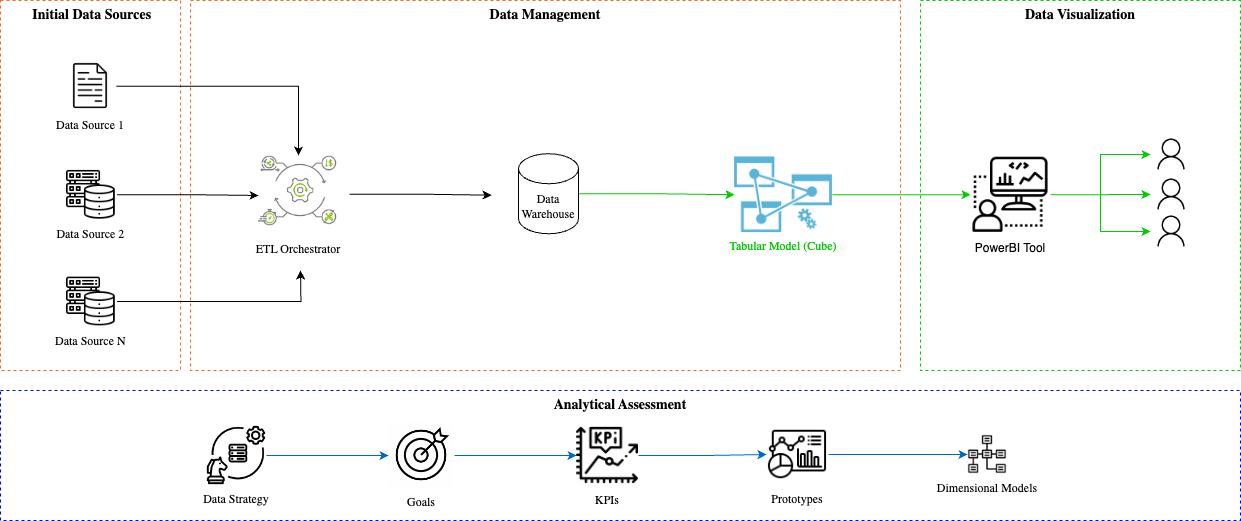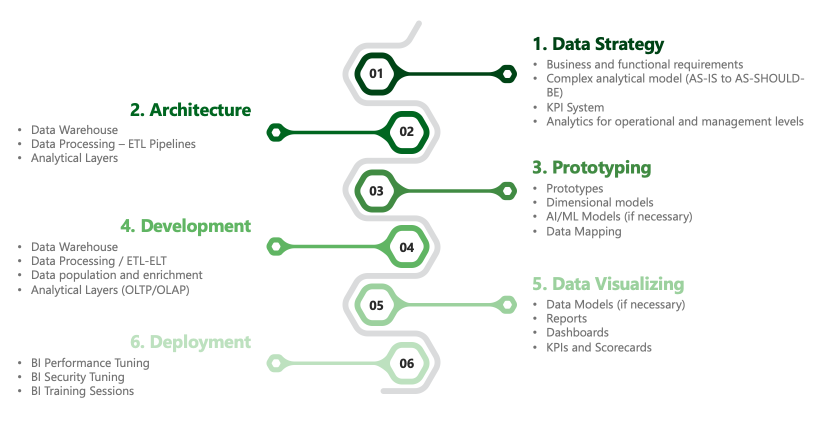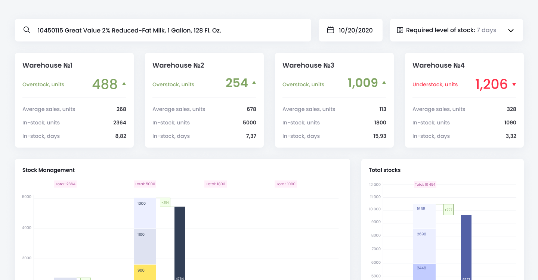PowerBI Business Intelligence Services
Power BI Dashboard Design
We have assisted many businesses in creating and tailoring personalized Power BI Dashboards that perfectly align with their brand image and corporate workflow. We create user-friendly dashboards, select visualizations, and configure data connections to make data analysis easier.
Power BI Development
Integration with Power BI
Our Power BI experts are adept at seamlessly integrating your Power BI solution with any third-party or internal CMS (Content Management System) or DMS (Document Management System) you use. They leverage open, standards-based REST APIs to incorporate your application or service with Power BI effortlessly.
Support & Maintenance
Our dedicated team of Power BI experts and support professionals is available round the clock, 24/7, to assist you with any challenges or issues you may encounter. With experience working under tight deadlines and in high-pressure situations, they ensure that your input, concerns, and queries are promptly addressed with swift responsiveness.
Power BI Consulting Services
Our Power BI consultants help organizations effectively implement and utilize Microsoft Power BI, a business intelligence and data visualization tool. Consultants work closely with organizations to understand their business objectives, data requirements, and reporting needs. This involves assessing the existing data infrastructure, identifying data sources, and determining the desired outcomes.
Power BI Predictive Analytics
Our Power BI consultants assist you in analyzing and predicting patterns within the ever-evolving business environment of customers, clients, prospects, and partners. They help you uncover valuable insights from the data to understand the dynamics and make informed decisions.
Whether it's about hiring Power BI experts, choosing the right Power BI tool, or performing a comprehensive analysis of your business with a single click - we are here to talk.
OUR SOLUTION
Data Visualization Services with PowerBI

Analytical Assessment

To create an analytical strategy, our Power BI development experts analyze how things are done, your goals, and decide on KPIs

Our data audits befor PBI software development involve collecting regional and industry information, analyzing market trends, and assessing company-specific factors
Data Management

Our system supports 100+ types of data sources (files, databases, cloud services, etc.) and ingests various data formats (relational, IoT, big data)

We keep your data well-organized for quality transformation

We run ETL procedures to integrate, clean, and enrich your data

Your data is secured through encryption, with workspace-level access to authorized users and row-level security for granular data visibility control
Data Visualization

Our team designs, develops, and implements PowerBI data visualization

Our insightful reports and visualizations are easily understood by all departments

We consolidate and visualize business data in one place using charts, cards, and maps

We can also add AI/ML modules on demand for advanced and predictive analysis
How We Build Your PowerBI Solution

In our approach, we don't assign one person to handle multiple responsibilities. Instead, we have speacialists who manage each aspect of the work in their respective fields. This guarantees high-quality and professional outcomes
 BI Business Analyst
BI Business Analyst
- Requirement gathering
- Data stories
- Data mapping
- Data verification
- QA
 BI Project Manager
BI Project Manager
- Requirement gathering
- Estimation & budget
- Resource management
- Project rituals & artefacts
- Reporting & Closing
 BI Architect/ Tech Lead
BI Architect/ Tech Lead
- Architecture & Tech Stack
- Tech team management
- Project planning
- Tech audit
 BI DevOps
BI DevOps
- Environments configuration
- Connection configuration
- Security management
- Productivity refinement
 Data Engineer
Data Engineer
- DWH configuration
- ETL/ELT Pipelines
- ETL/ELT scripts
- Data quality
- Data transformation & enrichment
- Analytical layer configuration
 Data Scientist/ Data Analyst
Data Scientist/ Data Analyst
- Data strategy
- Complex Analytical models
- Prototyping
- Dimensional models
- Data modelling
- Data vizualization
It's Easy to Hire Power BI Developers With Belitsoft
Depending on the size and growth of your products and services, you might need the assistance of a Power BI developer or even a remote developer team to ensure the smooth operation of your business. If you're a startup or a company building an MVP, your product is likely to expand beyond its initial framework. Hiring dedicated developers can ensure that your Power BI solutions remain up-to-date and in sync with your evolving needs.
- Share your project. Tell us about your project, and we will recommend developers from our talent pool who are best suited to translate data needs of your business stakeholders into dashboard requirements.
- Plan your strategy. During this stage, we'll establish the specifics of our collaboration, including the scope of work for the developers, the hiring model, and the designated time frames.
- Interview️ candidates. Receive vetted candidate profiles that match your engineering needs. We typically offer multiple options for skilled developers in various technologies. You can assess the proficiency level of our Power BI developers, using your preferred qualification tests, to ensure they have the necessary experience in the tools and technologies your project requires.
- Hire developer candidates. When ready, select a developer to hire. The developer will be employed by us, but you will have complete control over their assigned tasks and work responsibilities.
- Team Scaling. We offer you the flexibility to adjust your Power BI development team size according to the project scope, whether that requires expanding or reducing the number of team members.
Flexible Hiring Model For Power BI Developers



Technologies and tools we use









Stay Calm with No Surprise Expenses
- You get a detailed project plan with costs associated with each feature developed
- Before bidding on a project, we conduct a review to filter out non-essential inquiries that can lead to overestimation
- You are able to increase or decrease the hours depending on your project scope, which will ultimately save you a lot of $
- Weekly reports help you maintain control over the budget
Don’t Stress About Work Not Being Done
- We sign the Statement of Work to specify the budget, deliverables and the schedule
- You see who’s responsible for what tasks in your favorite task management system
- We hold weekly status meetings to provide demos of what’s been achieved to hit the milestones
- Low personnel turnover rate at Belitsoft is below 12% per annum. The risk of losing key people on your projects is low, and thus we keep knowledge in your projects and save your money
- Our managers know how to keep core specialists long enough to make meaningful progress on your project.
Be Confident Your Secrets are Secure
- We guarantee your property protection policy using Master Service Agreement, Non-Disclosure Agreement, and Employee Confidentiality Contract signed prior to the start of work
- Your legal team is welcome to make any necessary modifications to the documents to ensure they align with your requirements
- We also implement multi-factor authentication and data encryption to add an extra layer of protection to your sensitive information while working with your software
No Need to Explain Twice
- With minimal input from you and without overwhelming you with technical buzzwords, your needs are converted into a project requirements document any engineer can easily understand. This allows you to assign less technical staff to a project on your end, if necessary
- Communication with your agile remote team is free-flowing and instantaneous, making things easier for you
- Our communication goes through your preferred video/audio meeting tools like Microsoft Teams and more
Mentally Synced With Your Team
- Commitment to business English proficiency enables the staff of our offshore software development company to collaborate as effectively as native English speakers, saving you time
- We create a hybrid composition, where our engineers work with your team members in tandem
- Work with individuals who comprehend US and EU business climate and business requirements
Frequently Asked Questions
Microsoft Power BI is a comprehensive collection of business intelligence tools. It helps to import, aggregate, and present data in immersive reports and visuals. The suite includes:
- Power BI Desktop: A Windows desktop application for creating detailed data analysis and reporting
- Power BI Service: An online platform for collaborating and distributing Power BI reports
- Power BI Report Server: An on-premises server to host Power BI reports, available with Premium licensing
- Power BI Embedded: A service to embed Power BI visuals, reports, and dashboards into your applications, creating a cohesive user experience
- Power BI Mobile: A mobile application that allows you to access Power BI reports on the go
- Power BI Report Builder: A tool for creating detailed paginated reports
Our PowerBI visualization and analytical solutions are tailored to enhance decision-making and operational efficiency in various job functions and industries:
- Corporate and management, streamlining high-level strategic planning and reporting
- Customer service, optimizing interaction tracking and resolution analytics
- Finance & Accounting, simplifying financial data consolidation and reporting
- Human Resources, improving workforce analytics and organizational insights
- Information Technology, managing IT service data and infrastructure analytics
- Marketing, both digital and traditional, for campaign analysis and ROI optimization
- Manufacturing, monitoring production processes and efficiency metrics
- Sales, analyzing sales trends and performance metrics
- Supply Chain and Logistics, optimizing logistics planning and supply chain visibility
- We can also customize our solution to meet your specific requirements and address other business tasks
Experienced Power BI developers handle a variety of responsibilities, including:
- Developing and managing Power BI
- Building intuitive dashboards, visual reports, KPI scoreboards
- Connecting with various data sources, transforming data for BI and importing it
- Constructing analysis services and reporting models
- Implementing low-level security and understanding the application security layer model
- Creating compatible multidimensional and tabular models
- Closer business monitoring thanks to rich and intuitive dashboards,
- Interactive reports, visualizations, and personalized dashboards for a single view,
- High level of security, privacy, compliance, and transparency with separate cloud data centers,
- Simple to use with a short learning curve,
- Low cost and fast turnaround,
- Frequent updates and up-to-date features and functions.
Yes, we can perform data modeling with Power BI, which is one of its key advantages compared to other business intelligence platforms. Power BI development enables you to effortlessly create advanced models that can address intricate data-related inquiries.
- Designing data models to transform raw data into valuable insights
- Developing interactive dashboards and visual reports
- Identifying and monitoring key performance indicators (KPIs)
- Analyzing and presenting data through easily understandable reports
- Establishing relationships between data sources and creating demonstrative data models
- Creating charts and documentation to explain algorithms, models, and relationships
- Designing, developing, testing, and deploying Power BI scripts
- Performing in-depth analytics
- Executing DAX queries and functions
- Analyzing and refining the current ETL process if necessary
- Developing a data warehouse and working with SSAS, SSIS, and SSRS
- Enhancing existing BI systems through redefinition and strategic/technical changes
- Creating custom charts and implementing custom calculations
- Utilizing SQL queries for optimal results
- Applying filters and graphs to facilitate data comprehension
- Collaborating with colleagues from various departments to gather suggestions for performance improvement.
The must and nice-to-have skills to look for when hiring Power BI developers are:
- Experience working with BI tools or in a data-focused role
- Proficiency in database management, SQL querying, data modeling, data warehousing, BI, and online analytical processing (OLAP)
- Familiarity with data science, BI, and data analytics concepts
- Understanding of data integration, data warehousing, BI, and presentation principles
- Hands-on experience with various BI tools and systems
- Ability to create data-rich dashboards, write DAX expressions, and implement low-level security in Power BI
- Capability to develop custom BI products using scripting and programming languages like R and Python
- Skill in transforming data into compelling narratives to facilitate data-driven decision-making
- Extensive knowledge and practical experience with Microsoft Business Intelligence stacks such as Power Pivot, SSRS, SSIS, and SSAS
- Analytical mindset and adeptness in problem-solving
- Effective communication of insights through charts, reports, and dashboards for clear understanding by all stakeholders
- Proficiency in developing custom BI solutions
- Strong interpersonal and client management skills
- Ability to adapt and respond quickly to evolving business requirements
- Commitment to staying updated with design and development best practices.
At Belitsoft, we carefully evaluate all our remote Power BI developers before introducing them to you. This ensures that only top-tier candidates — those who have excelled in our technical and communication assessments — are presented for your consideration. We aim to provide you with suitable options within days or weeks, depending on your company's specific requirements.
Based on the U.S. Bureau of Labor Statistics, software developers in the U.S. earned a median annual salary of $120,730 in May 2021. This translates to an hourly rate of approximately $70-100. It's important to note that this figure does not cover the additional expenses associated with hiring, which typically amount to around $4000 per new employee, according to Glassdoor.
The annual salary of your remote Power BI developers can vary significantly based on factors such as their years of experience, technical skills, education, and country of residence. However, in general, if the developer is based in Eastern Europe or Latin America, the hourly rate is typically 2 or 3 times lower compared to the US, UK, and Israel.
You can access Power BI for free, but the best experience comes with a Power BI Pro Subscription account, which you can purchase from the Microsoft Store. Many businesses opt for a subscribed account because it provides them with enhanced features compared to the free version.
Self-service BI is an approach to data analytics, reporting, and visualization that empowers users to create user-friendly dashboards independently. It allows users to easily handle data ingestion, process it, and conduct business operations smoothly. Analyzing data is straightforward and doesn't require complex programming code. Users can generate actionable dashboards without relying on third-party vendors, thereby eliminating any associated constraints.
On the other hand, managed Enterprise BI involves data flowing from multiple sources and is typically used by businesses for their operations. However, managed Enterprise BI can sometimes hinder effective business operations due to a potential lack of collaboration and valuable insights during data analysis. Companies often turn to outside vendors to refine their data sources, leading to budget limits and decreased productivity.
Portfolio

Recommended posts
Our Clients' Feedback




















.jpg)
















We have been working for over 10 years and they have become our long-term technology partner. Any software development, programming, or design needs we have had, Belitsoft company has always been able to handle this for us.
Founder from ZensAI (Microsoft)/ formerly Elearningforce